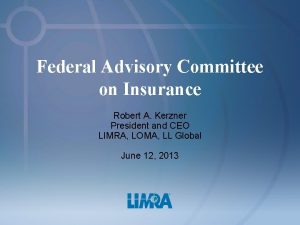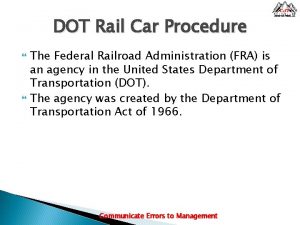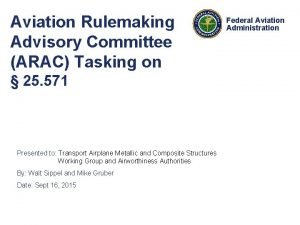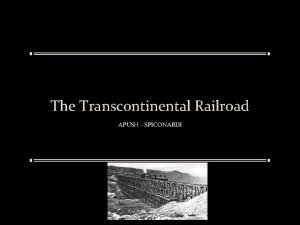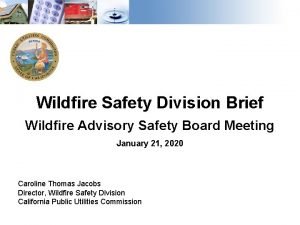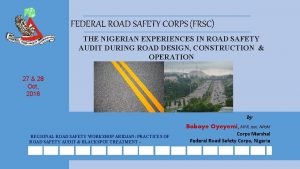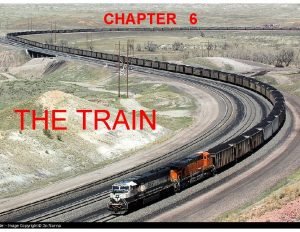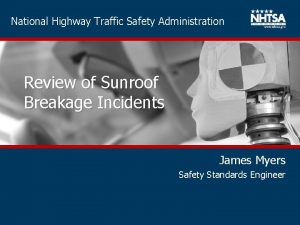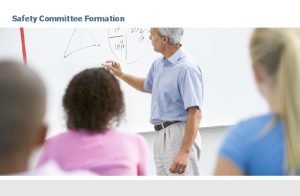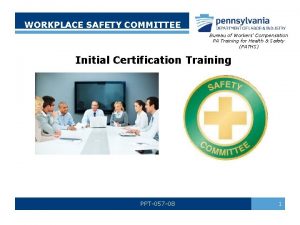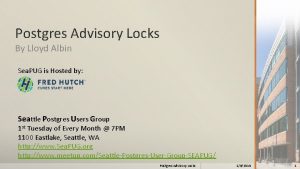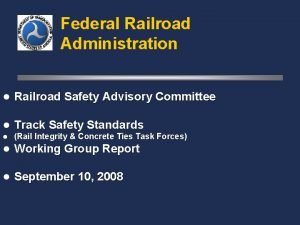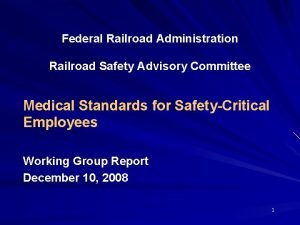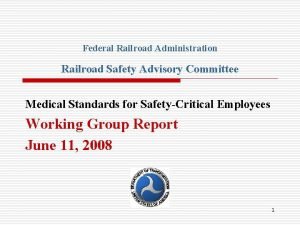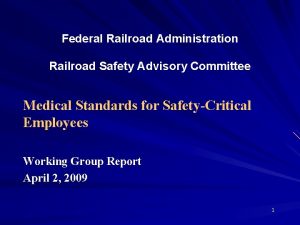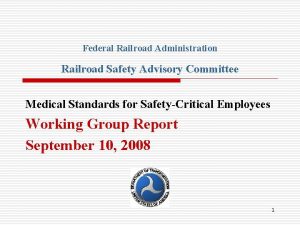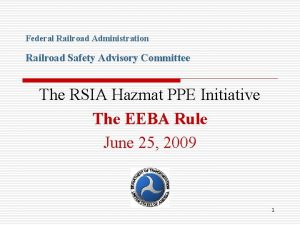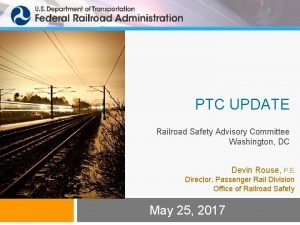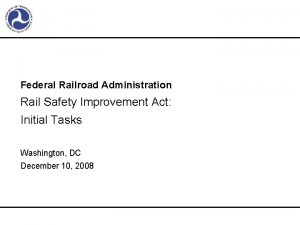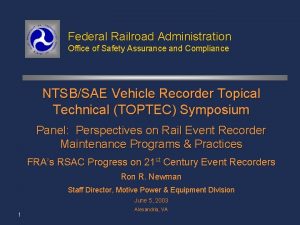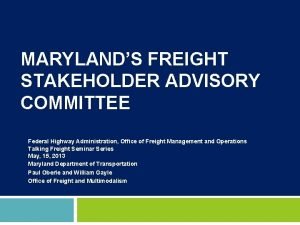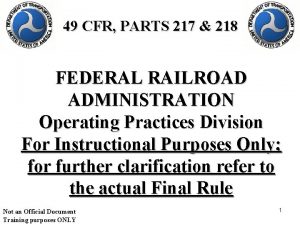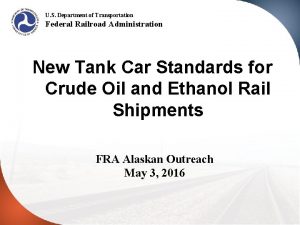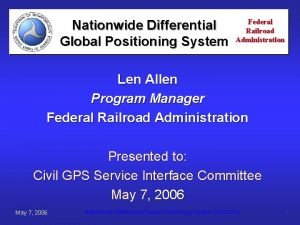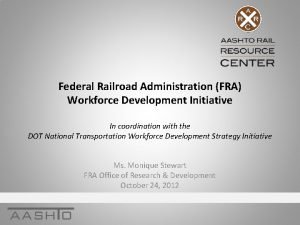Federal Railroad Administration l Railroad Safety Advisory Committee

























- Slides: 25

Federal Railroad Administration l Railroad Safety Advisory Committee l Track Safety Standards l (Rail Integrity & Concrete Ties Task Forces) l Working Group Report l December 10, 2008

Track Safety Standards Working Group Background l February 22, 2006 – With the RSAC approval of Task 06 -02, the Track Safety Standards Working Group was established to review and revise the CWR related provisions of the Track Safety Standards l December 1, 2008 FRA published a NPRM based on recommendations adopted at the February 20, 2008 meeting of the full Committee

Track Safety Standards Working Group Background l February 22, 2007 - RSAC approved Task 07 -01, and Working Group was tasked to; – Review controls applied to reuse of “plug rail” – Review the issue of cracks emanating from bond wire attachments – Consider improvements in the Track Safety Standards related to fastening of rail to concrete ties – Ensure a common understanding within the regulated community concerning requirements for internal rail flaw inspections

Track Safety Standards Working Group Background l September 10, 2008 - RSAC approved Task 08 -03, and Working Group was tasked to; – Factors that can and should be included in determining the frequency of internal rail flaw testing and a methodology for taking those factors into consideration with respect to mandatory testing intervals. – Whether the quality and consistency of internal rail flaw testing can be improved and how. – Whether adjustments to current remedial action criteria are warranted. – The effect of rail head wear, surface conditions and other relevant factors on the acquisition and interpretation of internal rail flaw test results.

Track Safety Standards Working Group Background The WG organized two Task Groups to act on the four items of Task 07 -01 : • Rail Integrity Task Group will discuss the three rail related items; and • Concrete Tie Task Group. The WG assigned Task 08 -03 (4 items) to the Rail Integrity Task Group

Track Safety Standards Working Group Track Standards WG met on November 20, 2008 – National Harbor, MD l 5 Meetings held by each Task Force – November 26 -29, 2007 - Washington D. C. – February 12 -14, 2008 - Washington D. C. – April 15 -17, 2008 – Omaha, NE – July 8 -10, 2008 – Silver Spring, MD – Sept 16 -18, 2008 – Silver Spring, MD Additionally – Concrete Tie Task Force met on Nov 19 -20, 2008 – National Harbor, MD

Track Safety Standards Working Group Rail Integrity Task Force Task No. : 07 -01 - Review the issue of cracks emanating from bond wire attachments – Background: Derailment in Tamaroa, IL February 9, 2003 – It was determined that a defect emanating from a bond wire attachment was the cause of the derailment

Track Safety Standards Working Group Rail Integrity Task Force NTSB issued recommendations that: – FRA consider cracks at bond wires as rail defects – FRA establish an accident cause code in its reporting system for derailments that result from cracks at bond wire installations – ERICO Products to correct inconsistencies in their installation instructions

Track Safety Standards Working Group Rail Integrity Task Force Current Status l FRA defect code 213. 16 – Rail Defect Originating from Bond Wire Attachment l FRA accident cause code T 224 – Rail Defect Originating from Bond Wire Attachment l Discussion on separate code for traction bonds and signal bonds. FRA will use one defect code covering both areas.

Track Safety Standards Working Group Rail Integrity Task Force Current Status ERICO Products has corrected inconsistency in their instruction: – Specifying that the bond locations are to be at the rail neutral axis (web) or within the confines of the joint bars – Clarification of the re-bonding process and instructions that chisels not be used. Bond wire should be cut and weld nugget removed by grinding – Specifications for minimum bond spacing when re-bonding near previously existing bonds

Track Safety Standards Working Group Rail Integrity Task Force RITF Proposal RITF consensus to approve and recommend to the full Track Standards Working Group that all defects associated with bonds will be reported to FRA in a single category, and that the recommendations concerning rail bonds under Task No. : 07 -01 be considered completed. No regulatory change. WG voted consensus approval that the Bond Wire section of Task No. 07 -01 has been completed during the November 20, 2008 meeting.

Track Safety Standards Working Group Concrete Crosstie Task Force Problem Statement and Task Force Objectives l Reply to NTSB report (R-06 -19) calling for specific limits of rail seat abrasion (deterioration), pad wear, missing or broken fasteners, loss of toeload pressure, improper fastener configuration, and excessive lateral rail movement in all Classes of Track l Understand the practical application and science of concrete crosstie rail seat deterioration, as well as, the failure mechanism (mechanical and compression)

Track Safety Standards Working Group Concrete Crosstie Task Force l Historically, crosstie ‘effectiveness’ is naturally subjective and requires good judgment in the application and interpretation of the standard l The ‘soundness’ of a crosstie is demonstrated when a 39 -foot track segment maintains safe track geometry and structurally supports the imposed wheel loads with minimal deviation l Currently, crossties are evaluated (inspected) individually by the ‘dimensional and functional’ criteria set forth in the regulations that are applied to wood, there are no direct specifications regarding crossties constructed of concrete in track Classes 1 -5

Track Safety Standards Working Group Concrete Crosstie Task Force l Development of concrete crosstie specifications included a performance-based system approach (crosstie and fastener) that will safely withstand vertical and lateral applied loads in an effort to reduce geometry-caused derailments when rail seat pad material deteriorates and exposes the rail base to the concrete l Understanding the science and failure mechanism of concrete crossties led to proposals for manual and automated concrete crossties inspection techniques and procedures, required corrective actions, and management of rail seat deterioration

Track Safety Standards Working Group Concrete Crosstie Task Force Current Status l l l Railroad, Labor, and FRA have deliberated and introduced draft concrete crosstie language over six (6) meetings since November 2007 Concrete Crosstie taskforce reached consensus on November 20, 2008 and provided its recommendation to the Track Safety Standards Working Group. The recommended changes are to the existing § 213. 109 and the introduction of a new section (213. 234 Automated Inspection) Working Group voted consensus approval that the Concrete Crosstie section of Task No. 07 -01 has been completed Note: Rail Safety Improvement Act of 2008 requires that regulations for concrete crossties be enacted no later than April 2010

Track Safety Standards Working Group Concrete Crosstie Task Force § 213. 109 Crossties (e) Concrete crossties counted to satisfy the requirements set forth in the table in paragraph (c), of this section shall not be: 1. 2. 3. 4. Completely broken through; Deteriorated or broken off in the vicinity of the shoulder or insert so that the fastener assembly can either pull out or move laterally more than ⅜ inch relative to the crosstie; Deteriorated such that the base of either rail can move laterally more than ⅜ inch relative to the crosstie on curves of 2 degrees or greater; or can move laterally more than ½ inch relative to the crosstie on tangent track or curves of less than 2 degrees; Deteriorated or abraded at any point under the rail seat to a depth of ½ inch or more;

Track Safety Standards Working Group Concrete Crosstie Task Force 5. Deteriorated such that the crosstie’s fastening or anchoring system is unable to maintain longitudinal rail restraint, or maintain rail hold down, or maintain gage due to insufficient fastener toeload: (i) If rail anchors are applied to concrete track, the combination of the crosstie, fastening, and rail anchor shall provide effective longitudinal restraint (ii) Where fastener placement impedes insulated joints from performing as intended, the fastener may be modified or removed, provided that the crosstie supports the rail 6. So deteriorated that the pre-stressing material has separated from or lost bond with the concrete resulting in the crosstie’s partial break-up, or cracks, which visibly expose pre-stressing material 7. Configured with less than two fasteners on the same rail, except as provided in e(5)(ii) of this paragraph

Track Safety Standards Working Group Concrete Crosstie Task Force § 213. 234 Automated Inspection of Track Constructed with Concrete Crossties (a) In addition to the track inspection required under § 213. 233 of this part, on Class 3 main track over which regularly scheduled passenger service trains operate, and for Class 4 and 5 main track, automated inspection technology shall be used as indicated in paragraph (b) below as a supplement to visual inspection. Automated Inspection shall identify and report exceptions to conditions described in § 213. 109 (e)(4) of this part

Track Safety Standards Working Group Concrete Crosstie Task Force (b) Automated inspections shall be conducted at the following frequencies: 1) 2) 3) 4) At least twice each calendar year, with no less than 160 days between inspections, if annual tonnage on Class 4 and 5 main track and Class 3 main track with regularly scheduled passenger service, exceeds 40 mgt annually; and At least once each calendar year, if annual tonnage Class 4 and 5 main track and Class 3 main track with regularly scheduled passenger service is less than 40 mgt annually On Class 3, 4 and 5 main track with exclusively passenger service, either an automated inspection or walking inspection must be conducted once per calendar year Track not inspected in accordance with (b)(1) and (b)(2) of this paragraph because of operational discontinuity shall be inspected within 45 days by a walking or automated inspection. If this inspection is conducted as a walking inspection, the next frequency inspection shall be an automated inspection as prescribed in this paragraph.

Track Safety Standards Working Group Concrete Crosstie Task Force (c ) Sections of tangent track 600 feet or less constructed of concrete crossties, including but not limited to, isolated track segments, experimental or test track segments, highway/rail crossings, and wayside detectors, shall be excluded from the requirements of this paragraph (d) The automated inspection measurement system of concrete crossties must be capable of determining exceptions to § 213. 109(e)(4) of this part (e) RESERVED

Track Safety Standards Working Group Concrete Crosstie Task Force (f) The automated inspection measurement system shall produce an exception report containing a systematic listing of all exceptions to § 213. 109(e)(4) of this part, identified so that an appropriate person (s) designated as fully qualified under § 213. 7 of this part could field verify each exception (1) later Each exception must be located and field verified no than 48 hours after the automated inspection (2) All field-verified exceptions are subject to all the requirements of part 213

Track Safety Standards Working Group Concrete Crosstie Task Force (g) The track owner shall maintain a record of the inspection data and the exception record for the track inspected in accordance with this paragraph for a minimum of two (2) years. The exception reports must include: (1) (2) (3) Date and location of limits of the inspection; Magnitude and location of each exception; and Results of field verification, and remedial action if required.

Track Safety Standards Working Group Concrete Crosstie Task Force The track owner shall institute the necessary procedures for maintaining the integrity of the data collected by the measurement system. At a minimum, the track owner shall: (h) (1) Maintain and make available to FRA documented calibration procedures by the measurement system which, at a minimum, shall specify an instrument verification procedure that will ensure correlation between measurements made on the ground and those recorded by the instrumentation (2) Maintain each instrument used for determining compliance with this section such that it is accurate to within 1/8 th of an inch for rail seat deterioration.

Track Safety Standards Working Group Concrete Crosstie Task Force (i) The track owner shall provide training for handling rail seat deterioration exceptions to all persons designated as fully qualified under § 213. 7 of this part and whose territories are subject to the requirements of § 213. 234. At a minimum, the training shall address: (1) Interpretation and handling of the exception reports generated by the automated inspection measurement system (2) Locating and verifying exceptions in the field and required remedial action (3) Recordkeeping requirements

Track Safety Standards Working Group Questions and Discussion
 Robert kerzner
Robert kerzner Federal railroad administration train car
Federal railroad administration train car Aviation rulemaking advisory committee
Aviation rulemaking advisory committee Nasa astrophysics advisory committee
Nasa astrophysics advisory committee Learning without burden is related to which committee
Learning without burden is related to which committee Trade union advisory committee
Trade union advisory committee Railroad administration apush
Railroad administration apush Rsoo
Rsoo Fha new deal relief recovery reform
Fha new deal relief recovery reform Wildfire safety advisory board
Wildfire safety advisory board Vision and mission of frsc
Vision and mission of frsc Federal safety appliance act
Federal safety appliance act Closed loop medication administration safety initiative
Closed loop medication administration safety initiative National highway safety administration reviews
National highway safety administration reviews Explain the causes of french revolution
Explain the causes of french revolution Committee of public safety
Committee of public safety Unsafe
Unsafe Safety committee formation
Safety committee formation Pa safety committee certification
Pa safety committee certification Safety care 2 person stability hold
Safety care 2 person stability hold Basic safety construction site safety orientation
Basic safety construction site safety orientation Process safety vs personal safety
Process safety vs personal safety Safety assessment for ind safety reporting
Safety assessment for ind safety reporting Catzoc ecdis definition
Catzoc ecdis definition Basic safety orientation
Basic safety orientation Pg_advisory_xact_lock example
Pg_advisory_xact_lock example
